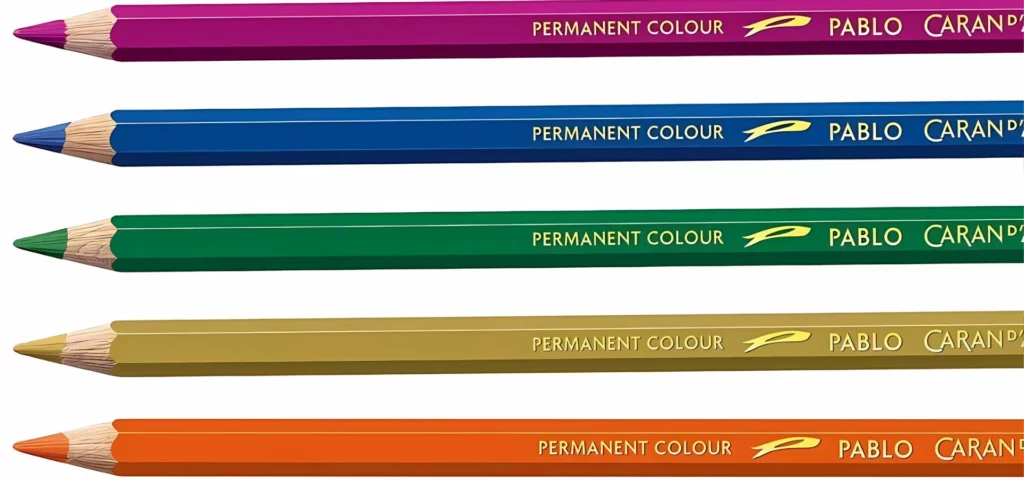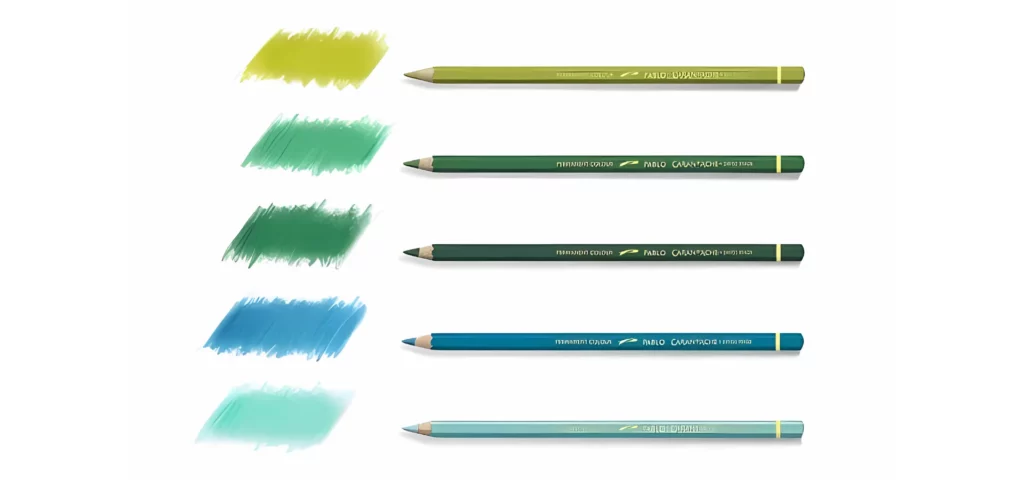Exploring Pablo Colour Pencils
Introduction to Pablo Pencils
Pablo Colour Pencils, a gem from the enchanting world of Caran D’Ache, are crafted for artists who seek nothing but the best. These high-quality colour pencils boast remarkable covering power and zero powder residue, enabling artists to create marvelously shaded, blended, and layered artworks with a rich, velvety finish (My Art Shop).
With these pencils in hand, one can effortlessly glide through their creative journey, leaving an array of vibrant colors in their wake. Whether it’s a portrait capturing every subtle nuance or a botanical piece bursting with life, Pablo Colour Pencils have got it all covered.
Unique Features of Pablo Pencils
Caran D’Ache Pablo Pencils come with a host of unique features that make them stand out in the crowded market of best colour pencils for artists. Below are some of their distinctive attributes:
| Feature | Description |
|---|---|
| Superior Colour Blending | These pencils offer exceptional colour blending, allowing artists to achieve smooth transitions and a harmonious colour palette (GrattitudeGremlin). |
| Covering Power | The covering power of these pencils is remarkable, ensuring that each stroke delivers maximum colour payoff without any powdery residue (My Art Shop). |
| Thicker Cores | Equipped with thicker cores containing more pigment, these pencils last longer than their average counterparts, providing artists with great value (GrattitudeGremlin). |
| Precision and Control | The premium quality of these pencils offers superior control, making them ideal for detailed work and intricate designs (GrattitudeGremlin). |
Pablo Pencils also come in a wide range of vibrant colours, offering artists the flexibility to choose shades that best suit their creative vision. The consistency in quality ensures that every pencil delivers the same high standard of performance, making them a reliable choice for any artistic endeavour.
With Pablo Colour Pencils, artists can elevate their artistry to new heights, blending and layering colours with the finesse of a maestro, and creating masterpieces that are as vivid and enduring as their imagination.
Choosing High-Quality Colour Pencils

When it comes to creating masterpieces, the choice of colour pencils can make all the difference. Selecting the right tools can elevate your artistic endeavors from drab to fab. Let’s dive into the factors to consider and the importance of quality in art supplies.
Factors to Consider
Choosing high-quality colour pencils involves multiple factors. Here are essential considerations for picking top-notch pencils:
- Pigment Quality:
- High-end pencils contain superior pigments, offering vibrant, rich colors. Professional brands typically use fewer, but higher quality pigments, allowing for nuanced tones and contrasts (GrattitudeGremlin).
- Core Thickness:
- The core thickness impacts the pencil’s lifespan and ease of use. Thicker cores contain more pigment, making them longer-lasting compared to their cheaper counterparts. If you’re tired of re-sharpening your pencils every few minutes, thicker cores may be your new best friend (GrattitudeGremlin).
- Durability:
- High-quality pencils are less likely to break under the pressure of inspired, furious sketching. Balancing delicacy and sturdiness is key.
- Blending Ability:
- Look for pencils that excel in blending. The ability to layer and mix colors effortlessly is a hallmark of premium art supplies, perfect for artists.
| Factor | Importance Level |
|---|---|
| Pigment Quality | High |
| Core Thickness | Medium |
| Durability | High |
| Blending Ability | High |
| Price | Medium |
Importance of Quality in Art Supplies
Why should one buy high-quality colour pencils? Here’s why investing in premium art supplies matters:
- Enhanced Performance:
- Quality pencils provide superior control and precision, enabling you to create more intricate and detailed artwork.
- Vibrancy and Longevity:
- Premium pencils, filled with higher quality pigments, translate to more vibrant and lasting pieces. For blending techniques, high-quality pigments create better blends and depth in your artwork.
- Consistency:
- Higher-grade pencils offer consistent performance, ensuring that from initial concept sketches to the final detailing, your pencils work as expected.
- Satisfaction and Confidence:
- Using high-quality materials boosts an artist’s confidence. When you know your tools won’t fail you, it’s easier to take creative risks.
- Versatility:
- Luxury pencils can handle various artistic techniques, from layering for depth to blending and shading, making them a versatile addition to your art supplies.
Investing in top-tier colour pencils can significantly boost your artistry. Remember, your creations deserve nothing but the best!
Pablo vs. Competitors
When it comes to high-quality colour pencils, Pablo is a brand that stands out. But how does it fare against its competitors? Let’s dissect this with a humorous twist!
Competitive Analysis Overview
Pricing, product features, and target audiences are crucial in evaluating high-quality colour pencils. Let’s look at how Pablo measures up against other popular brands.
| Brand | Unique Features | Target Audience |
|---|---|---|
| Pablo | Smooth application, lightfast | Professional and hobby artists |
| Faber-Castell | Vibrant pigments, eco-friendly | Art students, professionals |
| Prismacolor | Softcore leads, blendability | Artists, cartoonists |
| Derwent | Versatile, water-soluble options | Artists, illustrators |
Pablo’s Strengths and Weaknesses

Strengths
- Impeccable Quality:
- Lightfastness and smooth application make Pablo pencils highly desirable for serious artists.
- Balanced Pricing:
- Their pricing strategy strikes a balance without making your wallet weep.
- Diverse Color Range:
- Offers a variety of hues, enough to make a rainbow jealous.
- Durability:
- These pencils are built to last, so you won’t have to invest in frequent replacements.
Weaknesses
- Costly for Beginners:
- While balanced, they can still be a bit pricey for those just starting.
- Limited Availability:
- Not always available at local stores, may require online shopping (because we know how everyone loves waiting for deliveries!).
- Less Blendability:
- Compared to some brands like Prismacolor, Pablo pencils may take a bit more effort to blend.
SWOT Analysis Table
| Category | Pablo | Competitors |
|---|---|---|
| Strengths | Quality, Durability, Range | Pricing, Blendability |
| Weaknesses | Cost, Availability, Blendability | Longevity, Limited Range |
| Opportunities | Expanding Distribution, Starter Packs | Innovation, Sustainable Products |
| Threats | Market Saturation, New Entrants | Brand Loyalty, Technological Advancements |
For artists looking for the best colour pencils, understanding these comparisons can inform decisions about which brand aligns with their needs. Pablo pencils, despite a few weaknesses, shine brightly when it comes to producing stunning artworks. For more insights, visit our article on best colour pencils for artists.
The Art of Colour Pencils
When it comes to creating art with high-quality colour pencils, mastering blending and layering techniques can elevate your artwork from “meh” to masterpiece. Dive into the art of blending and layering with your Pablo pencils and unleash your creative prowess.
Blending Techniques
Blending is an essential skill in the realm of colour pencil artistry. It allows artists to create smooth transitions and beautiful gradients, transforming flat drawings into lifelike masterpieces. For those wielding high-quality Pablo pencils, blending is a breeze thanks to their creamy, highly pigmented cores.
Blending Methods:
- Burnishing: This technique involves applying heavy pressure to layer colours until the surface is smooth and polished. Pablo pencils are ideal for burnishing because of their soft, thick cores, loaded with pigment (GrattitudeGremlin).
- Solvent Blending: For a more painterly effect, artists can use solvents like mineral spirits or rubbing alcohol to dissolve the pencil pigment, turning it into a wash of colour. Solvent blending can make your colours pop and add depth to your artwork.
- Blender Pencils: Blender pencils are colourless tools that help meld different colours together without introducing any additional hues. They are perfect for achieving smooth transitions and can be a lifesaver when you’re aiming for subtlety.
Here’s a quick comparison of blending methods:
| Method | Pros | Cons |
|---|---|---|
| Burnishing | Smooth finish, vibrant colours | Can damage paper surface |
| Solvent Blending | Painterly effect, intense colours | Requires drying time |
| Blender Pencils | Soft transitions, no mess | Limited to small areas |
Layering for Depth
Layering is all about building up multiple layers of colour to create rich, complex artworks. When you use high-quality colour pencils, each layer interacts with the previous one, revealing new dimensions and adding depth to the piece.
Layering Techniques:
- Light to Dark: Start with light hues and gradually add darker tones. It gives you greater control over the final appearance and helps prevent muddiness.
- Crosshatching: This involves layering colours in intersecting lines. Crosshatching can add texture and depth, making your artwork more dynamic.
- Circular Motion: Using small circular strokes can help evenly distribute pigment and create a smooth, non-streaky layer. This technique works particularly well with Pablo pencils, renowned for their smooth application.
Artists should also consider the lightfastness of their colour pencils, especially for works intended to stand the test of time. Premium pencils often have better lightfast ratings, ensuring that your masterpiece won’t fade away (The Art Gear Guide).
The art of working with high-quality colour pencils like Pablo pencils not only brings out the best in your artwork but also makes the creative process more enjoyable. Whether you’re blending or layering, these techniques open up a world of possibilities, allowing you to craft stunning, professional-level pieces.
Must-Have Art Supplies
Every artist needs high-quality supplies to bring their creative visions to life. Whether you’re crafting a masterpiece with your high-quality colour pencils or just doodling, having the right tools on hand is crucial. Let’s dive into some must-have art supplies, focusing on sketchbooks and pads and tools for fine detailing.
Sketchbooks and Pads
A trusty sketchbook is like an artist’s best mate – always there to catch a fleeting idea or a meticulous drawing. When it comes to selecting the right sketchbook or pad, quality is paramount. The website My Art Shop offers a plethora of high-quality sketchbooks, pads, and diaries. Here are some factors to consider:
- Paper Weight: Heavier paper supports various mediums and prevents bleed-through.
- Texture: Smooth surfaces are perfect for detailed works, while textured surfaces hold more pigment and create interesting effects.
- Binding Type: Spiral-bound books lie flat, making them easier to work with, while hardbound books offer durability.
| Sketchbook Type | Spine Type | Paper Weight (gsm) | Ideal For |
|---|---|---|---|
| Spiral-bound | Spiral | 160 gsm | quick sketches and travel |
| Hardbound | Sewn | 200 gsm | mixed media works |
| Glue-bound | Glue | 170 gsm | journaling and daily doodles |
Tools for Fine Detailing
When it comes to fine detailing, the devil is in the details – literally. Having precise tools is essential for achieving those meticulous touches. Let’s look at some indispensable tools:
- Precision Sharpeners: A good sharpener ensures your pencils stay sharp and ready for fine work. The Caran D’Ache Double Hole Plastic Sharpener is a fantastic choice, accommodating both large (11mm) and small (8mm) pencil diameters (My Art Shop). It combines Swiss precision with a dash of whimsy; it’s designed with a smiley face and pop-out inserts to prevent shavings from causing a mini avalanche on your desk.
- Fine Detail Brushes: For those who love mixed media, having a set of fine detail brushes can make all the difference in small-scale, intricate work.
- Erasers: No, not just any run-of-the-mill eraser. Precision erasers like the kneadable ones can be shaped to erase tiny details without disturbing the surrounding area.
For finer detail, having a structured approach can help. Artists often layer colours to achieve depth, and precision tools can greatly enhance this process.
By integrating these must-have supplies into your art arsenal, you’ll be well-equipped to elevate your artistry. So, sharpen those pencils, grab your sketchbook, and let your creativity flow!
Fun Facts About Pencils
Ever wonder about the humble beginnings of your high-quality colour pencils? Buckle up, as we whisk you through the quirky past and the evolution of pencil manufacturing!
History of Pencils
The story of pencils begins in 1662, in the picturesque city of Nuremberg, Germany. This historic town became the cradle for the first mass-produced pencils in the world (Pencils.com). Here’s a timeline of pencil history highlights:
- 1662: Mass production of pencils commenced in Nuremberg, Germany.
- 1812: William Monroe crafted the first wood pencils in America, right in Concord, Massachusetts.
- Late 1800s: Renowned pencil-making individuals, like the philosopher Henry David Thoreau, contributed to the US pencil industry.
- 1890s: Pencils got a makeover with manufacturers starting to paint and brand them.
To make it even funnier, imagine Thoreau concocting the perfect pencil recipe while pondering nature!
| Year | Event | Location |
|---|---|---|
| 1662 | First mass-produced pencils | Nuremberg, Germany |
| 1812 | First wood pencils by William Monroe | Concord, Massachusetts |
| Late 1800s | German factories bolstering US pencil industry | New York and New Jersey |
| 1890s | Pencils began getting their colourful coats and brands | Various |
Evolution of Pencil Manufacturing
Pencil manufacturing has seen a stirring evolution, from naked wooden sticks to vibrant, high-tech tools for artists. Here’s how:
- Early 1900s: The transition from Eastern Red Cedar to California Incense-cedar began. This Californian wood won the lumberjack’s lottery for being strong, abundant, and perfect for pencils (Pencils.com).
- Factory Flourish: Regions like New York and New Jersey became the pencil-making hubs of America, thanks to the setup of factories by prominent German manufacturers (Pencils.com).
- Painted Beauties: By the 1890s, pencils shifted from their natural, barewood look to being painted and branded. This not only added flair but differentiated quality pencils in the market (Pencils.com).
Now, whether it’s the elegant Pablo pencils or other best colour pencils for artists, the evolution of pencil manufacturing has made sure you’re never out of options for creating your next masterpiece.
Pencils have come a long way from their humble beginnings, evolving into the essential tools of creativity we know and love today.

